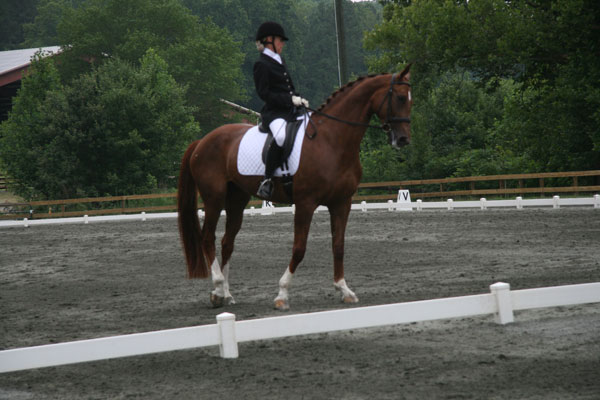
It seems that I’ve been judging a lot of Second Level tests lately, which means that I’m also seeing a lot of turns on the haunches. These turns—and also the transition from walk to canter—are often not ridden as specified in the tests, which is painfully obvious to the judges since it happens right in front of their noses.
Here’s what the USEF Rule Book says about the preparation for walk turns: “The ‘turn on the haunches’ is executed out of medium walk prepared by half-halts to shorten the steps a little and to improve the ability to bend the joints of the hindquarters.” The way the turn reads on the test sheet itself is: “Shorten stride, half turn on haunches.” And the canter depart reads: “Shorten the stride in walk, collected canter.”
The part that gets omitted is the “shorten stride” phase. It’s right there in black and white, and it’s always clearly hollered out by readers. So, if a rider leaves out that ‘shorten stride” part, is this technically an error? (Nope.) A grey area? (Sort of.) Even though the test is not being ridden as specified, it can be hard for the judge to tell if the half-halts to get that preparation are really coming through—it’s something the rider can feel, in a way, better than the judge can see. But, the judge can clearly see the result of a poorly prepared walk turn, especially if the strides seem to get longer rather than shorter! The judge likely won’t comment—or score—on the lack of preparation, but he certainly will on the result.
I think the walk turns frustrate Second Level riders more than any other movement there. They certainly can frustrate the judges. It helped a lot when the rule book added a clarification that the turn could be as large as a meter, because much of the time the riders were attempting the turn too small and then running into all sorts of problems.
The walk shown at Second Level is medium walk, but ideally the walk turn and walk–canter transition should be entered through collected walk. Hence there should be a couple clear steps that are shorter/quicker behind before the turn or the canter. What usually happens when I don’t see those shorter/quicker steps is that the canter transition has a couple trot steps, or it goes hollow. Same thing with the walk turn, which sticks, or goes large, or the legs cross. Sometimes the walk turn or canter depart is successful without the brief shorter/quicker interlude. However, if the rider correctly gets that brief moment of increased activity in the walk, then the likelihood that the canter depart and walk turn will turn out well is clearly increased.
The test writers really are trying to help out the riders here in several ways, even though the riders don’t always seem to be aware of it. The test writers are looking forward to the day when the rider and horse must do a true walk pirouette and also a true canter pirouette, and then further along to the transitions needed to get increased activity behind for piaffe and passage, plus a lot of other good stuff along the way. This brief transition is the important first step towards those goals.
Picture in your mind a canter pirouette. There is a moment of “pirouette canter” before the turn there, where the horse “sits” more behind. The Fourth Level tests all have separate movements to gradually increase the awareness of this transition and the ability to adjust the canter for a few steps. It’s very similar to what happens earlier at Second Level. The rider wants to be able to easily access the shorter/quicker steps described above so she can readily ask the horse for anything she wants.











